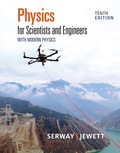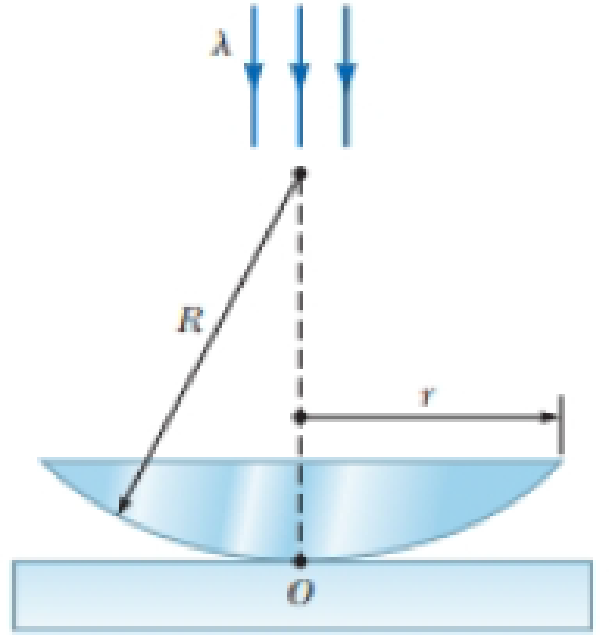
Physics for Scientists and Engineers with Modern Physics
10th Edition
ISBN: 9781337671729
Author: SERWAY
Publisher: Cengage
expand_more
expand_more
format_list_bulleted
Concept explainers
Textbook Question
Chapter 36, Problem 37AP
In a Newton’s-rings experiment, a plano-convex glass (n = 1.52) lens having radius r = 5.00 cm is placed on a flat plate as shown in Figure P36.37. When light of wavelength λ = 650 nm is incident normally, 55 bright rings are observed, with the last one precisely on the edge of the lens. (a) What is the radius R of curvature of the convex surface of the lens? (b) What is the focal length of the lens?
Figure P36.37

Expert Solution & Answer
Trending nowThis is a popular solution!

Students have asked these similar questions
let a beam of x rays of wavelength 0.125 nm be incident on an NaCl crystal at angle u 45.0° to the top face of the crystal and a family of reflecting planes. Let the reflecting planes have separation d = 0.252 nm. The crystal is turned through angle f around an axis perpendicular to the plane of the page until these reflecting planes give diffraction maxima. What are the (a) smaller and (b) larger value of f if the crystal is turned clockwise and the (c) smaller and (d) larger value of f if it is turned counterclockwise?
The lens in a Newton’s rings experiment has diameter 20 mm and radius of curvature R = 5.0 m. For l = 589 nm in air, how many bright rings are produced with the setup (a) in air and (b) immersed in water (n = 1.33)?
In a Newton’s-rings experiment, a plano-convex glass (n = 1.52) lens having radius r = 5.00 cm is placed on a flat plate as shown . When light of wavelength λ = 650 nm is incident normally, 55 bright rings are observed, with the last one precisely on the edge of the lens. (a) What is the radius R of curvature of the convex surface of the lens? (b) What is the focal length of the lens?
Chapter 36 Solutions
Physics for Scientists and Engineers with Modern Physics
Ch. 36.2 - Which of the following causes the fringes in a...Ch. 36.3 - Using Figure 36.6 as a model, sketch the...Ch. 36.5 - One microscope slide is placed on top of another...Ch. 36 - Two slits are separated by 0.320 mm. A beam of...Ch. 36 - Prob. 2PCh. 36 - A laser beam is incident on two slits with a...Ch. 36 - Prob. 4PCh. 36 - Prob. 5PCh. 36 - Light with wavelength 442 nm passes through a...Ch. 36 - Prob. 7P
Ch. 36 - A student holds a laser that emits light of...Ch. 36 - Coherent light rays of wavelength strike a pair...Ch. 36 - In Figure P36.10 (not to scale), let L = 1.20 m...Ch. 36 - Prob. 11PCh. 36 - Prob. 12PCh. 36 - In the double-slit arrangement of Figure P36.13, d...Ch. 36 - Monochromatic light of wavelength is incident on...Ch. 36 - Prob. 15PCh. 36 - Show that the distribution of intensity in a...Ch. 36 - Prob. 17PCh. 36 - Monochromatic coherent light of amplitude E0 and...Ch. 36 - Prob. 19PCh. 36 - Prob. 20PCh. 36 - Prob. 21PCh. 36 - Prob. 22PCh. 36 - When a liquid is introduced into the air space...Ch. 36 - Prob. 24PCh. 36 - Prob. 25PCh. 36 - Prob. 26PCh. 36 - Prob. 27PCh. 36 - Prob. 28APCh. 36 - Prob. 29APCh. 36 - Prob. 30APCh. 36 - Prob. 31APCh. 36 - Prob. 32APCh. 36 - In a Youngs double-slit experiment using light of...Ch. 36 - Prob. 34APCh. 36 - Figure P36.35 shows a radio-wave transmitter and a...Ch. 36 - Prob. 36APCh. 36 - In a Newtons-rings experiment, a plano-convex...Ch. 36 - Prob. 38APCh. 36 - A plano-concave lens having index of refraction...Ch. 36 - Prob. 40APCh. 36 - Interference fringes are produced using Lloyds...Ch. 36 - A plano-convex lens has index of refraction n. The...Ch. 36 - Prob. 43APCh. 36 - Prob. 44APCh. 36 - Prob. 45APCh. 36 - Prob. 46CPCh. 36 - Prob. 47CPCh. 36 - Prob. 48CPCh. 36 - Prob. 49CPCh. 36 - Prob. 50CP
Knowledge Booster
Learn more about
Need a deep-dive on the concept behind this application? Look no further. Learn more about this topic, physics and related others by exploring similar questions and additional content below.Similar questions
- A beam of 580-nm light passes through two closely spaced glass plates at close to normal incidence as shown in Figure P27.23. For what minimum nonzero value of the plate separation d is the transmitted light bright?arrow_forwardIn the double-slit arrangement of Figure P37.21, d = 0.150 mm, L = 140 cm, A = 643 nm, and y = 1.80 cm. (a) What is the path difference d for the rays from the two slits arriving at P? (b) Express this path difference in terms of A. (c) Does P correspond to a maximum, a minimum, or an intermediate condition? Give evi- dence for your answer. Viewing screenarrow_forwardConsider a light wave passing through a slit and propagating toward a distant screen. Figure P37.53 shows the intensity variation for the pattern on the screen. Give a mathematical argument that more than 90% of the transmitted energy is in the central maximum of the diffraction pattern. Sugges- tion: You are not expected to calculate the precise percent- age, but explain the steps of your reasoning. You may use the identification 1 1 8 Imax asine -3T -27 -T 27 37 A Figure P37.53 ||arrow_forward
- = 35. Figure P36.35 shows a radio-wave transmitter and a receiver separated by a distance d 50.0 m and both a distance h = 35.0 m above the ground. The receiver can receive sig- nals both directly from the transmitter and indirectly from signals that reflect from the ground. Assume the ground is level between the transmitter and receiver and a 180° phase shift occurs upon reflection. Determine the longest wave- lengths that interfere (a) constructively and (b) destructively. h Transmitter d Receiver Figure P36.35 Problems 35 and 36.arrow_forwardIn the figure, first-order reflection from the reflection planes shown occurs when an x-ray beam of wavelength 0.820 nm makes an angle θ = 62.3˚ with the top face of the crystal. What is the unit cell size a0?arrow_forwardA plano-convex lens with radius of curvature R = 3.2 m is in contact with a flat plate of glass. A light source and the observer's eye are both close to the normal, as shown in the figure below. The radius of the 51st bright Newton's ring is found to be 9.4 mm. What is the wavelength of the light produced by the source? nm 2//1 Need Help? Read It 8:36 PM 4/11/2021arrow_forward
- Ch26,P24arrow_forwardThe Michelson interferometer can be used to measure the index of refraction of a gas by placing an evacuated transparent tube in the light path along one arm of the device. Fringe shifts occur as the gas is slowly added to the tube. Assume 580-nm light is used, the tube is 5.40 cm long, and 152 fringe shifts occur as the pressure of the gas in the tube increases to atmospheric pressure. What is the index of refraction of the gas? Hint: The fringe shifts occur because the wavelength of the light changes inside the gas-filled tube. (Give your answer to five decimal places.) 4.0arrow_forward35. Figure P36.35 shows a radio-wave transmitter and a receiver separated by a distance d - 50.0 m and both a distance A - 35.0 m above the ground. The receiver can receive sig- nals both directly from the transmitter and indirectly from signals that reflect from the ground. Assume the ground is level between the transmitter and receiver and a 180° phase shift occurs upon reflection. Determine the longest wave- lengths that interfere (a) constructively and (b) destructively. Transmitter Recriver Figure P36.35 Problems 35 and 36.arrow_forward
- In the double-slit arrangement of Figure P36.13, d=0.150 mm, L= 140 cm, λ = 643 nm. and y= 1.80 cm (a) What is the path difference δ for the rays from the two slits arriving at P? (b) Express this path difference in terms of λ. (c) Does P correspond to a maximum, a minimum or an intermediate condition? Give evidence for your answer. Figure P36.13arrow_forwardA Newton’s rings apparatus is to be used to determine the radius of curvature of a lens . The radii of the nth and (n + 20)th bright rings are found to be 0.162 and 0.368 cm, respectively, in light of wavelength 546 nm. Calculate the radius of curvature of the lower surface of the lens.arrow_forwardA parallel X-ray beam is diffracted by sodium chloride. Strong first-order is obtained when the Bragg angle (the angle between the crystal planes and the emerging beam) is 6º 50’. The distance between the planes that are in the reflection position in the crystal is 2,8 Å. 1 angstron = 1 Å = 0,1 nm. a) What is the wavelength of X-rays?arrow_forward
arrow_back_ios
SEE MORE QUESTIONS
arrow_forward_ios
Recommended textbooks for you
 Physics for Scientists and Engineers with Modern ...PhysicsISBN:9781337553292Author:Raymond A. Serway, John W. JewettPublisher:Cengage Learning
Physics for Scientists and Engineers with Modern ...PhysicsISBN:9781337553292Author:Raymond A. Serway, John W. JewettPublisher:Cengage Learning Principles of Physics: A Calculus-Based TextPhysicsISBN:9781133104261Author:Raymond A. Serway, John W. JewettPublisher:Cengage Learning
Principles of Physics: A Calculus-Based TextPhysicsISBN:9781133104261Author:Raymond A. Serway, John W. JewettPublisher:Cengage Learning

Physics for Scientists and Engineers with Modern ...
Physics
ISBN:9781337553292
Author:Raymond A. Serway, John W. Jewett
Publisher:Cengage Learning

Principles of Physics: A Calculus-Based Text
Physics
ISBN:9781133104261
Author:Raymond A. Serway, John W. Jewett
Publisher:Cengage Learning
Spectra Interference: Crash Course Physics #40; Author: CrashCourse;https://www.youtube.com/watch?v=-ob7foUzXaY;License: Standard YouTube License, CC-BY